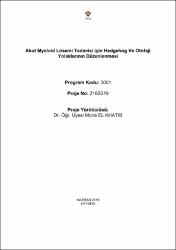| dc.contributor.author | EL KHATIB, Mona | |
| dc.date.accessioned | 2024-03-18T12:42:25Z | |
| dc.date.available | 2024-03-18T12:42:25Z | |
| dc.date.issued | 2019 | en_US |
| dc.identifier.uri | https://hdl.handle.net/20.500.12573/2015 | |
| dc.description.abstract | Akut myeloid lösemi (AML) çeşitli moleküler aberasyonlar ve sinyal yolaklarındaki bozuklukları
içeren klonal hastalıklar ile karakterize edilen bir grup heterojen malignanttır. Hedgehog (HH)
sinyal yolağı birçok kanserde deregüle edilen evrimsel olarak korunan bir sinyal yolağıdır. HH
sinyal yolağı lizozomal degradasyon prosesi otofajinin temel regülatörü olan PI3K/AKT/mTOR
aksesini de içeren diğer sinyal yolakları ile karşılıklı iletişim halindedir. Bu sinyal yolakları
AML’de deregüle edilmiştir. Birçok çalışmada otofajinin AML için bir kaçış mekanizması
olabileceği ortaya konulmuştur. Bizim çalışmamızda, HH ve otofaji yolaklarının farklı AML
türleri üzerine etkileri incelenmiştir. Çalışmamızda KML hücresi olan K562 ve CMK, MV4-11,
MOLM-13 ve NB4 AML hücreleri GLI1 inhibitörü GANT61 ve farklı otofaji modülatörleri ile
muamele edilmiştir.MTT sonuçları NB4, MOLM-13 ve MV4-11hücre proliferasyonun GLI
inhibisyonu sonrasında düştüğünü ancak CMK’nin diğer AML hücre hatlarına kıyasla GLI
inhibisyonuna daha az sensitif olduğunu ortaya koymuştur. Daha sonra, otofaji
modülasyonunun farklı AML hücre hatlarının proliferasyonu üzerine etkileri incelenmiştir.
Otofajinin gerek otofagozom-lizozom füzyonu aşamasında gerekse otofagolizozomal
degradasyon aşamasında inhibisyonunun ilaç konsantrasyonu ve muamele süresine bağlı
olarak AML sağkalımını azalttığı gözlemlenmiştir. Otofaji modülatörleri ve GANT61’in
kombinasyonunun MOLM-13 hücre hattı üzerinde sinerjistik bir etkisinin olduğu fakat CMK
hücre hattı üzerinde sinerjistik etkisinin olmadığı gözlemlenmiştir. GANT61 muamelesinin AML
hücre hatlarında otofajiyi artırdığı LC3II ekspresyonu ile western blot yöntemi ile ortaya
konulmuştur. Buna ek olarak, kombinasyonun MOLM-13 hücresinde LC3II’yi artırdığı
gözlenirken, bu oran CMK hücre hattında daha düşüktür. AKT proteinin ekspresyonu ilaca ve
hücre hattına gore farklılık göstermektedir. Sonuç olarak, HH ve otofaji sinyal yolaklarının
hedeflenmesi MOLM-13 hücre hattı için umut vaatedici bir terapi iken, CMK hücre hattında
benzer sonuçlara ulaşılamamıştır. | en_US |
| dc.description.abstract | Acute myeloid leukemia (AML) is a heterogeneous group of malignancies characterized by
clonal disorders with diverse molecular aberrations and dysregulation in signaling pathways.
Hedgehog (HH) signaling pathway is an evolutionary conserved signaling pathway that is
deregulated in many cancers. HH pathway crosstalks with other pathways among which is the
PI3K/AKT/mTOR axes, a main regulator of autophagy, a lysosomal degradation process.
These pathways are deregulated in AML. Several studies suggested that autophagy
modulation could be an escape mechanism in AML. In this study, we investigated the effect of
Hedgehog pathway and autophagy on different subsets of AML cell lines. We have treated
CMK, MV4-11, MOLM-13 and NB4 AML cell lines, in addition to K562, CML cells, with GANT
61, GLI1 inhibitor, and different autophagy modulators. MTT assay have showed that GANT61
resulted in a significant decrease in the proliferation of NB4, MOLM-13, and MV4-11, however,
CMK showed less sensitivity to GLI inhibition compared to other AML cell lines. Then, we
proceeded with checking the effect of autophagy modulation on the survival of the different
AML cell lines. Inhibiting autophagy whether at the autophagosome-lysosome fusion stage or
autophagolysosomal degradation stage led to a decrease in the survival of AML to a certain
degree based on the drug concentration and timepoint of treatment. Combination treatment of
autophagy modulators and GANT61 had a synergistic effect in MOLM-13 but not in CMK.
GANT61 treatment increased autophagy in AML cell lines that was correlated with an increase
in the expression of LC3II detected by western blotting. Also, combination treatment elevated
that increase in LC3II in MOLM-13 cell lines but less in CMK cell lines. AKT protein expression
changed depending on the type of treatment and cell lines. In conclusion, targeting of HH and
autophagy is a promising therapy against MOLM-13 cell line but not against CMK. | en_US |
| dc.language.iso | eng | en_US |
| dc.publisher | TUBİTAK | en_US |
| dc.rights | info:eu-repo/semantics/openAccess | en_US |
| dc.subject | Acute Myeloid Leukemia | en_US |
| dc.subject | Hedgehog | en_US |
| dc.subject | Autophagy, | en_US |
| dc.subject | PI3K/AKT/mTOR | en_US |
| dc.subject | Combination therapy | en_US |
| dc.subject | Akut myeloid lösemi | en_US |
| dc.subject | Hedgehog | en_US |
| dc.subject | Otofaji | en_US |
| dc.subject | kombinasyon terapi | en_US |
| dc.title | Akut Myeloid Lösemi Tedavisi için Hedgehog Ve Otofaji Yolaklarının Düzenlenmesi | en_US |
| dc.type | other | en_US |
| dc.contributor.department | AGÜ, Yaşam ve Doğa Bilimleri Fakültesi, Moleküler Biyoloji ve Genetik Bölümü | en_US |
| dc.contributor.institutionauthor | EL KHATIB, Mona | |
| dc.identifier.startpage | 1 | en_US |
| dc.identifier.endpage | 73 | en_US |
| dc.relation.journal | Tubitak | en_US |
| dc.relation.tubitak | 216S319 | |
| dc.relation.publicationcategory | Diğer | en_US |


















